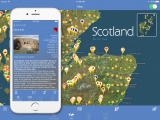<< News >> Could this be the face of neanderthal art?
Submitted by PaulM on Sunday, 30 November 2003 Page Views: 6384
DiscoveriesArchaeologists claim to have found the world’s first piece of neanderthal art during excavation of a French cave, writes Jonathan Leake. If confirmed, the discovery could reignite the fierce debate over neanderthals, whom many archeologists believe were largely incapable of the abstract thought needed to create art.The artefact comprises a stone shaped to resemble a human face with a hole running through it. A bone has been wedged into the hole giving the impression of facial decoration.
Details will appear in Antiquity, a scholarly journal, this month. Jean-Claude Marquet, curator of the departmental museum of prehistory at Le Grand-Pressigny, will describe how he found the artefact on the banks of the Loire alongside other neanderthal remains.
Radiocarbon dating suggests sediments were about 35,000 years old — from a time when neanderthals were dying out.
Marquet suggests the head began as a small flint block whose natural shape evoked a human face and that a neanderthal chipped it into an even closer resemblance. “The human appearance hits one with astonishing force. Its presence in a neanderthal habitation cannot be fortuitous,” he said.
He points out that neanderthals had other practices consistent with developing art including burying their dead and also used naturally occurring colouring materials such as red ochre and manganese dioxide, which is black. They also made tools and weapons.
Neanderthals arrived in Europe about 300,000 years ago, spreading out across most of the continent and possibly to Britain. They are thought to have lived mainly as mobile hunter-gatherers, probably in bands of up to 30 individuals.Their decline began with the arrival of modern humans from Africa, probably about 45,000 years ago. Neanderthals probably vanished about 30,000 years ago, so Marquet’s find just predates their demise.
Paul Mellars, professor of prehistory and human evolution at Cambridge and author of The Neanderthal Legacy, described the find as fascinating.
He added: “If this piece accurately dates to the neanderthal period it is a unique discovery. But it is much cruder than homo sapiens’ art of the same era and suggests a very different level of conceptual planning.”
Professor Chris Stringer, head of human origins at the Natural History Museum in London, said: “This is a very simple piece and although it probably was made by a neanderthal it is not enough to prove they were capable of abstract thought.”
Source: The Sunday Times 30 November 2003
<< Introducing the Stone Age Diet
Circle in Germany Oldest Observatory, Linked to Nebra Disc >>






 We would like to know more about this location. Please feel free to add a brief description and any relevant information in your own language.
We would like to know more about this location. Please feel free to add a brief description and any relevant information in your own language. Wir möchten mehr über diese Stätte erfahren. Bitte zögern Sie nicht, eine kurze Beschreibung und relevante Informationen in Deutsch hinzuzufügen.
Wir möchten mehr über diese Stätte erfahren. Bitte zögern Sie nicht, eine kurze Beschreibung und relevante Informationen in Deutsch hinzuzufügen. Nous aimerions en savoir encore un peu sur les lieux. S'il vous plaît n'hesitez pas à ajouter une courte description et tous les renseignements pertinents dans votre propre langue.
Nous aimerions en savoir encore un peu sur les lieux. S'il vous plaît n'hesitez pas à ajouter une courte description et tous les renseignements pertinents dans votre propre langue. Quisieramos informarnos un poco más de las lugares. No dude en añadir una breve descripción y otros datos relevantes en su propio idioma.
Quisieramos informarnos un poco más de las lugares. No dude en añadir una breve descripción y otros datos relevantes en su propio idioma.